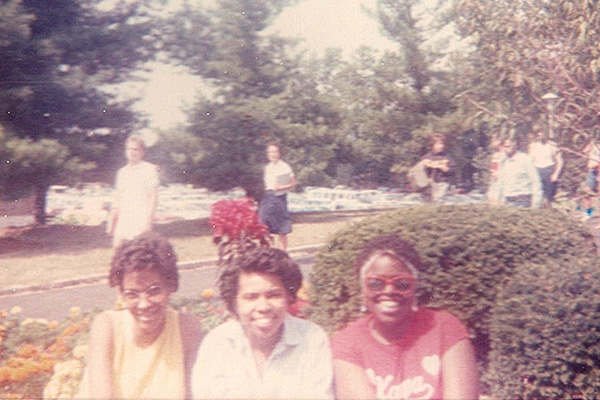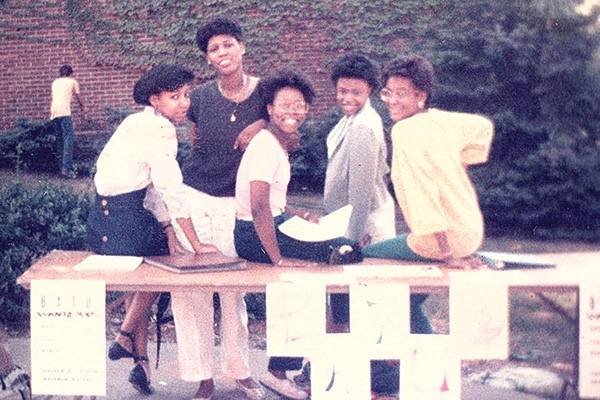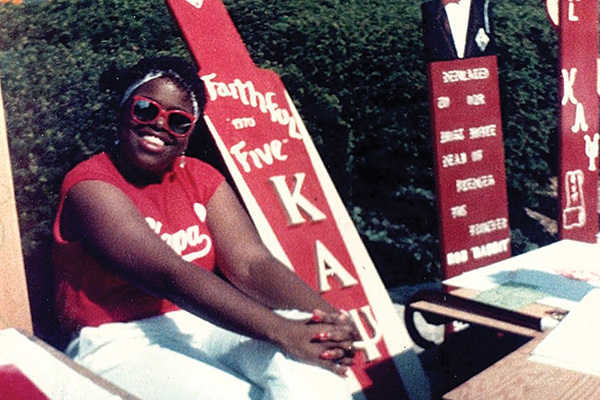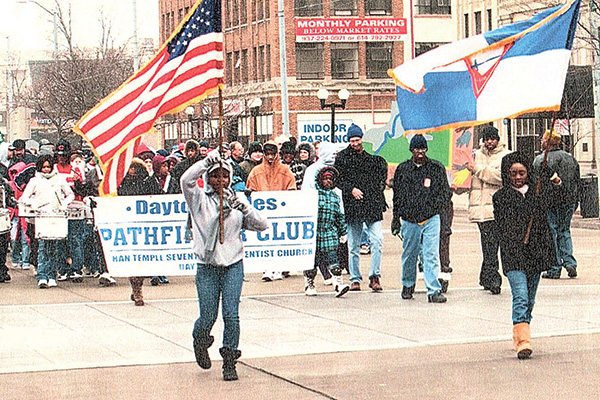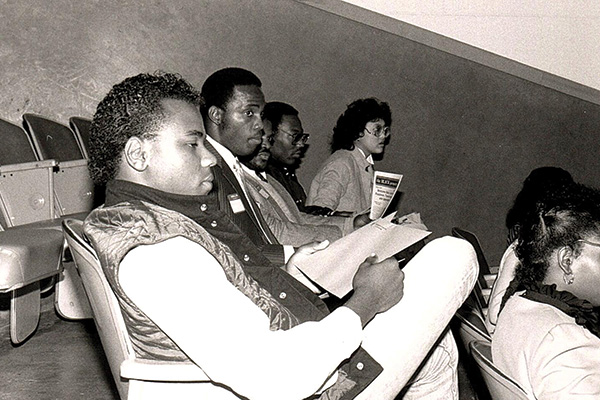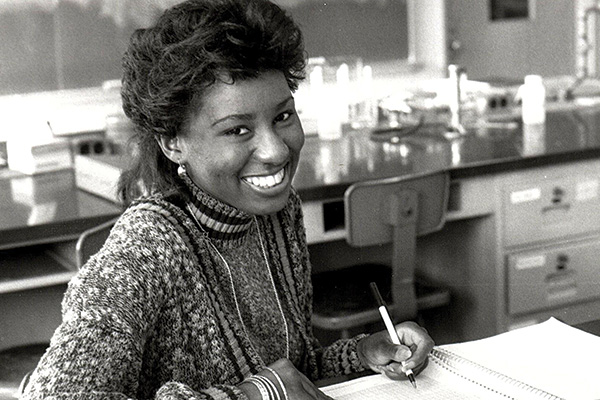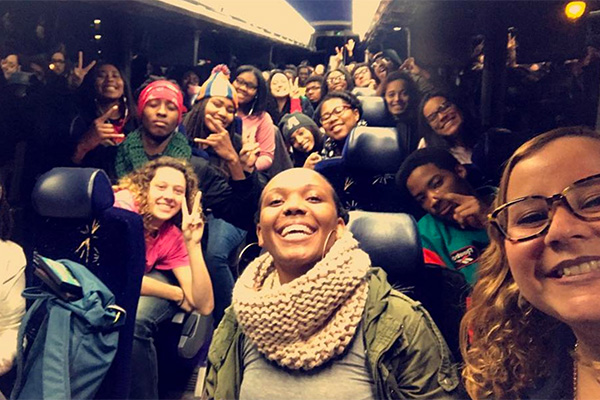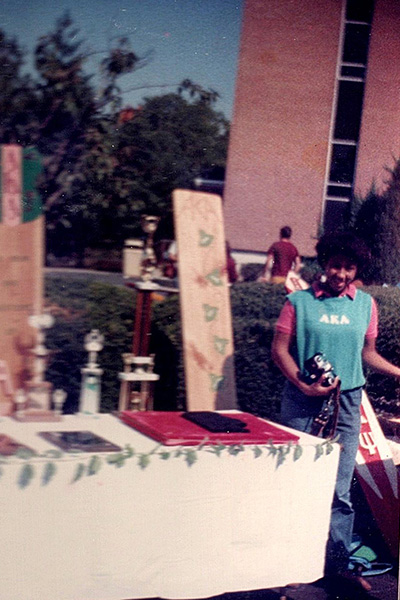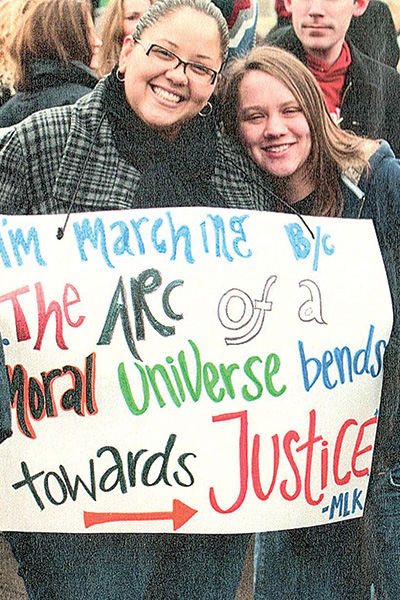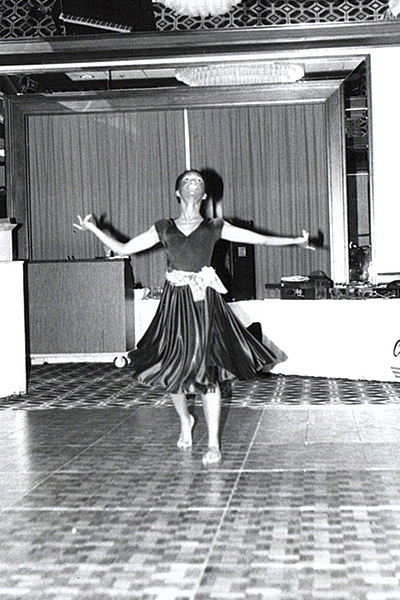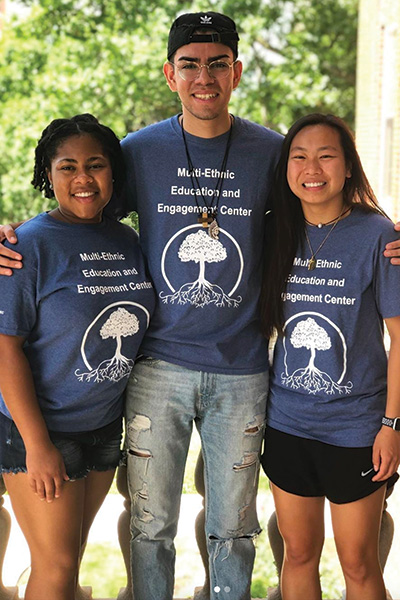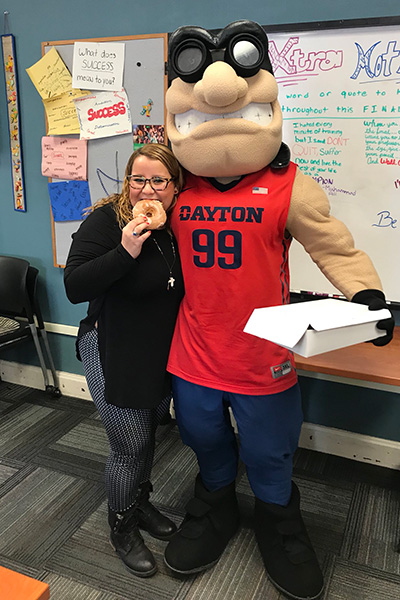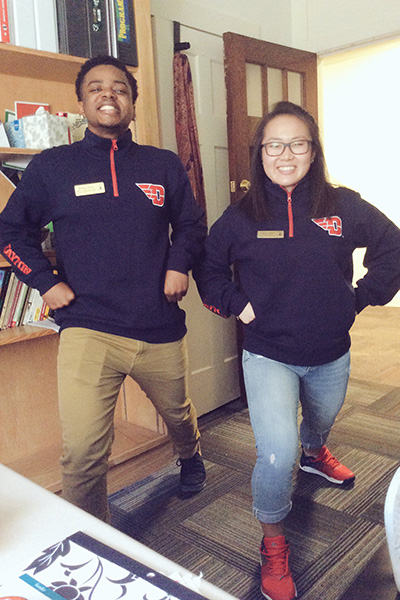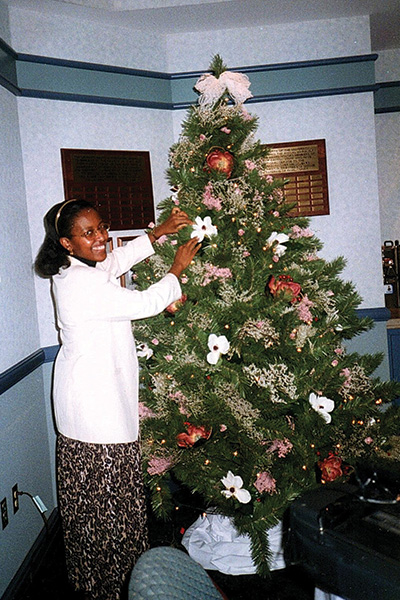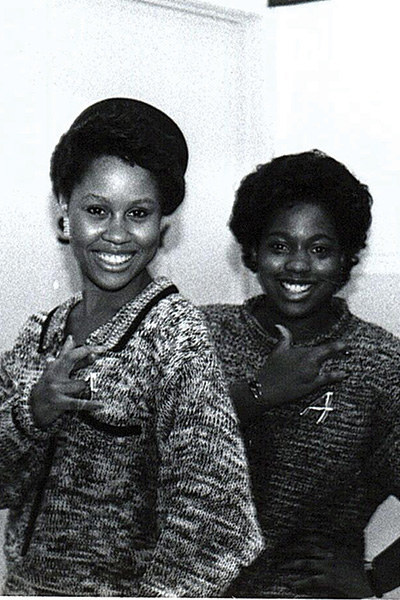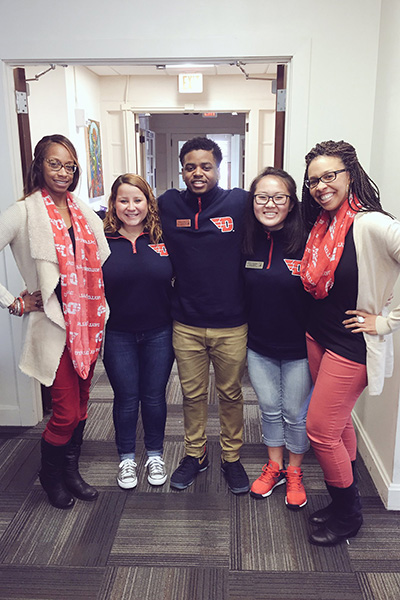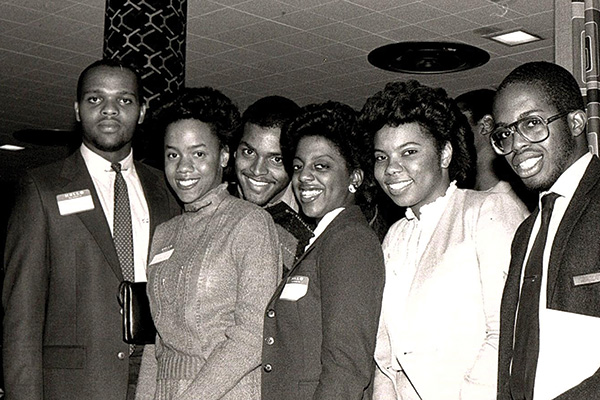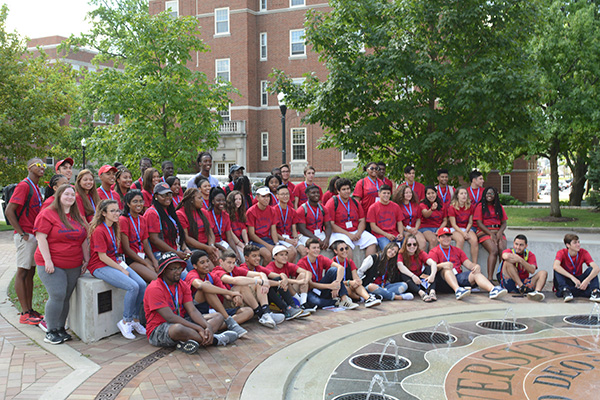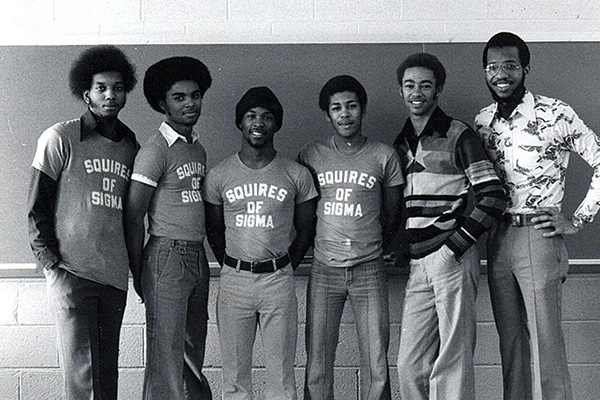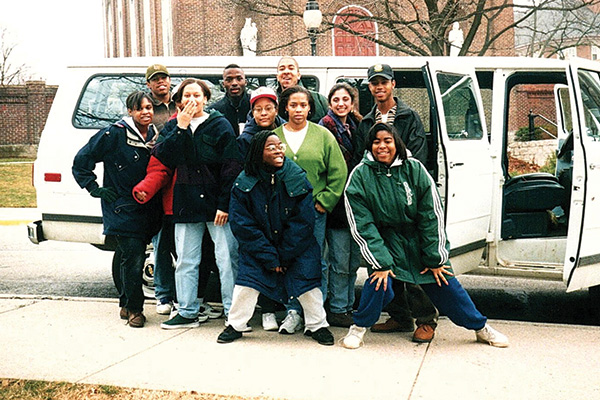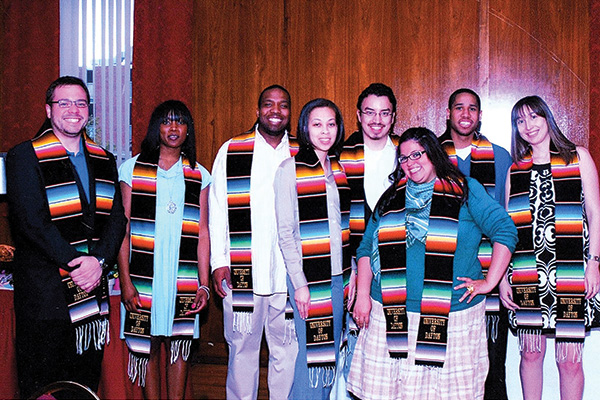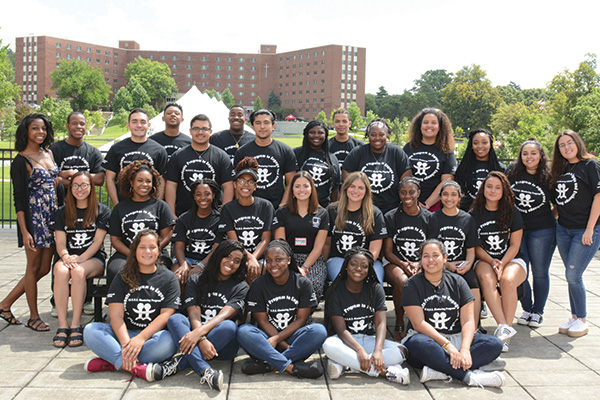Welcoming to all
For years, Daria-Yvonne Jackson Graham ’94 considered herself a graduate of the Office of Minority Student Affairs. Her identification as a University of Dayton alumna came later.
“The office was essential to me as a student,” she said. “Many times, multicultural students and students from underrepresented populations will identify more with the center than they do with UD. I know I felt that way when I graduated.”
Graham’s perspective would come full circle when she returned to UD five years after graduation as a staff member in housing and residence life. She’d later serve as director of the center where she felt the most acceptance as a Black student at a predominantly white institution and worked to engage thousands of students of color with the center and, ultimately, the University.
Now known as the Multi-Ethnic Education and Engagement Center, UD’s cultural center for traditionally underrepresented students is celebrating its 50th anniversary this year of contributing to and supporting students’ educational, social and cultural development. Of the 8,322 full-time undergraduate students enrolled in fall 2020, about 16% identified as Black, Hispanic/Latinx, Asian and Pacific Islander, Native American or two or more races — making the current student body the most diverse in school history and emphasizing the continuing importance of MEC’s work to make UD welcoming to all.
Defining the mission
Cultural centers on college campuses emerged from the social unrest of the 1960s and ’70s as Black students across the nation began demanding that predominantly white institutions become more intentional in addressing their needs. Schools should not only confront and condemn racist actions from other students, faculty and administrators, the students stated, but they should also develop the framework for a more diverse and inclusive curriculum and provide greater institutional support for minority students to succeed academically and graduate.
UD was no exception to this cultural movement. In 1969, members of the Black Action Through Unity student organization staged a sit-in and presented a list of demands to University administration they believed would improve the experience of Black students at UD. In 1970, the University responded with the creation of the African and Afro-American Program, which became the Center for Afro-American Affairs in 1971. Launched as an academic program with courses and faculty in African and Afro-American studies, it evolved into a comprehensive center in O’Reilly Hall that included social and cultural programming.
“It was a space to go, a place to connect.”
“It was a space to go, a place to connect. It was the place to be on campus for Black students and the center of our UD experience,” said Kathleen Henderson ’86, a UD student in the late 1970s and the current director of college access, success and transitions.
In the mid-1980s, the center became the Office of Minority Student Affairs. Debra Plousha-Moore ’89, who served as associate dean of students and the center’s director from 1986-96, wanted the center’s work to focus on not only academic success but also leadership development, community service and social development for students of color.
Plousha-Moore said there were pockets of resistance across campus questioning the need for such services, but she aimed to make the case that racial diversity was imperative for the betterment of all students, and students of color should have a positive experience at UD.
“I wanted to serve as a champion, an advocate and a spokesperson for people of color — both students and faculty — and provide the Dayton community with an access point to the campus,” Plousha-Moore said. “I wasn’t prepared for students of color at UD to have a ‘less than’ experience. I wanted them to have an equal experience.”
“I wasn’t prepared for students of color at UD to have a ‘less than’ experience. I wanted them to have an equal experience.”
Research on the experiences of students of color at predominantly white universities points to the importance of cultural centers. They are central to students’ sense of belonging, with the centers often serving as a consistent safe space for acceptance and support. In “Recasting College Outreach Approaches to Engage African-American Alumni,” a December 2014 paper in the Journal of African American Studies, the authors note the importance of cultural centers for Black alumni developing a positive association with their university.
“The classroom environment for many of these students constituted tumultuous ground,” the paper stated. “The experiences that African American alumni report are reflected in the extant research that chronicles the oftentimes difficult engagements that Black students have historically encountered and continue to encounter with American higher education. It was there, in these very classroom contexts, that many of these students reported being abused, humiliated and frustrated due to their status as minority students in a majority institution.”
The paper notes that establishing cultural centers and multicultural offices generates positive experiences for current and incoming Black and minority students. The hope is that this will lead to developing “an active, inspired and willing minority alumni base,” the paper reported.
From her own experience and experiences with other Black alumni, Graham said a positive connection to the institution doesn’t emerge until about five or six years after graduation. That hiatus gives students who might have felt marginalized from the larger college experience a chance to process that period, and perhaps even develop a sense of forgiveness for their experiences on the margins.
“This center is there because someone should feel at home everyplace on campus, but society has shown us that’s not true,” said Graham, who left UD in June to become dean of students and associate vice president of student affairs at California State University, San Bernardino. “And universities are microcosms of society.”
This is not to say that all students of color at UD experienced overt racism or discrimination — but simply addressing stereotypes or offhanded comments about race could exact a burden, Henderson said.
“Even if there wasn’t overt hostility, you were still living on a predominantly white campus,” she said. “This was a period where many students, Black and white, came from working-class backgrounds, and many white students had never met a Black person before. We were all still going through those early stages of human development, and we were living in a post-Vietnam and post-civil rights movement era, so there were some awkward statements and some periods of tension for Black students.”
The presence of the Office of Minority Student Affairs, along with encouragement from Black administrators such as Plousha-Moore and Henderson, who led the center in the ’90s, were vital to Graham’s feeling of belonging and support at UD.
Plousha-Moore understood that need, citing stories from students of color who told her about how they experienced daily life at UD, from the high expectations they felt about being the only person of color in their classes to conflict about speaking up about racial issues in class discussions.
“The tax of being a person of color at the University of Dayton was clearly evident,” Plousha-Moore said.
In the 1990s, a national shift was underway in examining the role of cultural centers in providing a comprehensive range of services for underrepresented students. Research and anecdotal evidence were illustrating how some students might need assistance with their classwork or encouragement that they were academically strong enough to succeed despite negative comments from white classmates. Other students might be struggling to obtain food during times dining facilities were closed. UD expanded the center’s offerings with those concepts in mind to address all factors that could negatively affect learning outcomes.
Today, the center includes an academic success specialist position and a student engagement assistant position, which gives upperclass students the opportunity to provide peer support.
“MEC has allowed me to put ‘Learn. Lead. Serve.’ into action.”
“MEC has allowed me to put ‘Learn. Lead. Serve.’ into action,” said Lena Clerici, a senior chemical engineering major from Mars, Pennsylvania. “To the students MEC serves, it’s home. From participating in events to speaking at rallies, I have been supported by MEC on my journey, and it has provided me with opportunities to support others. I hope after four years, I’ll have been able to give back to MEC as much as it gave me.”
Expanding its reach
In the 1990s, the center also began to formalize its support for other domestic minority students whose numbers were growing at UD.
Jessica González Uhlig ’96, an administrator at St. Mary’s University in San Antonio, was one of 30 first-year students to arrive at UD from Puerto Rico in fall 1992. She remembers when the group showed up at an international student event at the start of the year and were told that they weren’t international students because of Puerto Rico’s status as a U.S. commonwealth.
She remembers how the students felt adrift — not quite belonging with the overall UD community population as bilingual students who connected with the Spanish language and Hispanic/Latinx culture but too American to be considered international.
“Diverse Student Programs adopted us,” she said, noting the center’s name change in 1995 to reflect the influx of Hispanic/Latinx students involved in its programming. Those students engineered a petition drive for more services to address their specific needs, and the center conducted a survey to determine how it could best serve them. The center would hire its first academic adviser specifically for Hispanic/Latinx students, and the students played a significant role in starting the first Hispanic Heritage Month celebration on campus.
“In the middle of the day in September, KU Plaza was the place to see and be seen,” Uhlig said, recalling how the students played music and danced and celebrated. “We were just loud and obnoxious and got into so much trouble, but it was fantastic. This is why I always say I have gratitude for UD. They stepped up and listened to us. They embraced us and allowed us to be.”
“They stepped up and listened to us. They embraced us and allowed us to be.”
Uhlig would later work with Graham as a co-director of the Office of Multicultural Affairs from 2007-10, a period in which the center changed its name again after expanding its programming to include a growing population of Asian-American and Native American students, and students who identified as multiracial.
From the start, the center helped facilitate campus events and celebrations to represent the diversity of the student body and expose the entire campus to diverse perspectives on topical issues. Students of all races are welcome to enjoy heritage celebrations, galas and symposia. The center, now located in Alumni Hall, also serves as a gathering place for discussions, dinners, movie nights, study sessions, game watches, interest club meetings, and sometimes, just hanging out.
“It has been and continues to be home away from home for me,” said Joshua Chambers, a senior international business management major from Tinley Park, Illinois. “MEC allows us to experience a true sense of belonging by embracing and encouraging the diversity of UD students. MEC is like a family to me.”
Victoria Bordfeld ’15 participated in OMA activities sparingly as an undergraduate but became more involved when she took a role as graduate assistant of leadership initiatives within the office from 2015-17. She helped lead the organization and implementation of the University’s celebration of Martin Luther King Jr., which expanded from one week to two weeks of speakers and events. She also led what was then called Kindred Presidents, a meeting of leadership teams for about 15 multicultural organizations the center supports.
As an undergraduate resident assistant, Bordfeld said she didn’t feel isolated from the greater UD experience because of her interaction with the students on her floor. But as an OMA graduate assistant, she noticed how many students of color found a sense of community there they might not have experienced in their residence halls.
“That’s what makes OMA and MEC so special,” said Bordfeld, who came to UD from Freehold, New Jersey. “You can always find common ground with someone, and it creates a safe space where people are willing to share their opinion and challenge each other in a productive way.”
“It creates a safe space where people are willing to share their opinion and challenge each other in a productive way.”
Bordfeld was one of those students who became empowered to challenge others within OMA. As one of just a handful of Asian American students at UD, she at first felt the OMA atmosphere didn’t reflect her lived experience.
“It’s tough when people assumed that I came from an Asian country every time I walked into a classroom and then assumed that I can speak on behalf of all Asians,” she said. “I did feel a bit of a disconnect as an undergrad because I was told that my stereotypes weren’t as bad, but a stereotype is still a stereotype. While I recognize my own privilege that my stereotypes don’t put me in harm’s way many times, it was a little off-putting to be told that you’re thought of as just genetically smarter. I still worked hard. Being able to contribute that perspective when I was a graduate student was so important, and I was happy to share my story and perspective.”
When Bordfeld applied for — and was accepted to — a dietetic internship at the University of Alabama at Birmingham, she articulated the importance of understanding and serving the needs of diverse populations. Now a registered dietitian with the Women, Infants and Children program in Dayton, Bordfeld credits OMA for that perspective, one the center’s leaders have stressed as vital to the University’s mission of educating all students to work in an increasingly diverse and global society.
A multicultural future
In 2018, the University welcomed what was then its most diverse class in history. The center continued its mission of supporting underrepresented students, but it also looked to expand its social justice and diversity education by partnering more with academic affairs to increase curricular options.
With those demographic changes and expanded goals in mind, the center adopted its current name in 2019.
“In 1986, the roadmap was evident through the mission, the vision, the strategy,” said Plousha-Moore, who now serves on the UD board of trustees and owns a consulting firm. “I see people much more competent in the language of diversity, and I see the support throughout the entire organization.”
Mérida Allen, a veteran student development professional who took over as associate dean of students and MEC executive director in July, is prepared to lead the center during a new era of protest and change. As demonstrations against racial injustice erupted around the world in response to the death of George Floyd at the hands of police, UD issued a statement — signed by 33 administrators — affirming its commitment to becoming an anti-racist institution. Anti-racism is defined as taking direct action against racial inequities and viewing racism as a universal problem that all can take action to end.
Allen says MEC is well-positioned to have a powerful voice in this effort.
“We need to continue to make sure that we’re informed and informing others about the experiences of those who may have been victims of racism on campus and in their everyday lives,” Allen said. “All students can engage in learning how to be an ally, and there needs to be a space where people are having this dialogue. The work of MEC is not only to empower and support underrepresented students, but also to provide an educational space for our entire campus.”
